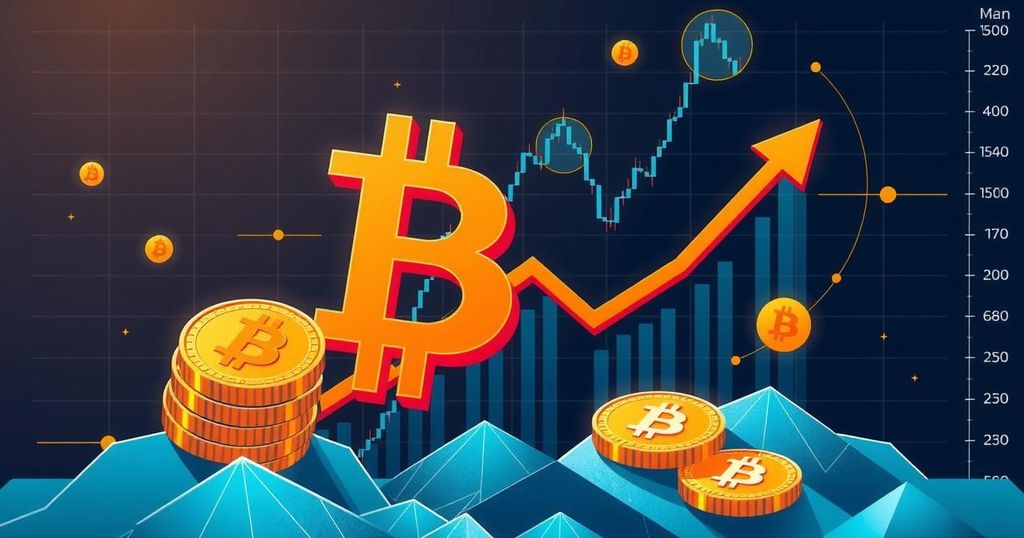Analyzing the Implications of Fed Rate Cuts on the Cryptocurrency Sector
The Federal Reserve’s recent 0.5 percentage point interest rate cut has led to increased optimism among cryptocurrency investors for heightened liquidity and growth potential. Historically, such cuts have positively influenced crypto prices, as seen in Bitcoin’s previous surge. However, the risks of inflation and potential economic instability necessitate a cautious approach. The unique dynamics of the crypto market, including Bitcoin’s upcoming halving, may further impact trends following this rate change.
The recent decision by the Federal Reserve to reduce its benchmark interest rate by 0.5 percentage points marks a pivotal shift in monetary policy, with potential repercussions for the cryptocurrency sector. This is the first cut in rates by the Fed in over four years, and while it has been met with optimism from crypto investors who foresee a boost in liquidity and growth opportunities, it is essential to approach this optimism with caution due to accompanying risks. Historically, reductions in borrowing costs have correlated with a more risk-tolerant market, often translating to price increases in digital assets. For example, between 2020 and 2022, Bitcoin experienced a remarkable surge of 375% when rates were at historically low levels. As we now witness the Fed’s current easing of rates, investors are left to speculate if a similar trajectory will follow. Nevertheless, the increased liquidity from the rate cuts may also stir inflation concerns, prompting investors to seek inflation hedges such as Bitcoin. Investors must consider if the advantages offered by this rate cut have already been factored into market prices, especially given that speculation around rate movements has likely influenced current valuations. The recent 50 basis-point reduction could also indicate underlying concerns regarding the economy’s health, thus potentially dampening enthusiasm towards cryptocurrencies. Furthermore, unique crypto market dynamics, including Bitcoin’s upcoming halving in April 2024, could compound the impacts of this monetary policy adjustment. Historically, Bitcoin halvings have led to pronounced price rallies in subsequent months. Additionally, seasonal trends in the crypto market suggest that September is often a weak month, but a resurgence may occur in October, which aligns conveniently with the Fed’s rate cut. This, combined with the growing accessibility of spot exchange-traded funds (ETFs), could further increase the influx of capital from traditional markets into cryptocurrency, enhancing demand. Investors should remain cognizant of the unpredictable nature of markets and the potential for inflationary pressures to arise from this policy shift. Careful monitoring of the Federal Reserve’s subsequent moves and macroeconomic indicators will be crucial for determining the trajectory of the crypto sector in this evolving landscape. In conclusion, while the Fed’s recent reduction in interest rates has the potential to invigorate innovation and investments in the digital asset space, it is accompanied by significant challenges and uncertainties. Investors are encouraged to remain informed and judicious in navigating this shifting economic environment, balancing the opportunities against the inherent risks of the market.
The Federal Reserve’s interest rate policy plays a crucial role in shaping economic conditions, particularly through its influence on liquidity and borrowing costs. Rate cuts are intended to stimulate economic activity by making it cheaper to borrow money, which can lead to increased consumer spending and investment. As a consequence, these cuts often impact various asset classes, including cryptocurrencies, by altering investor sentiment and risk perception. With the cryptocurrency market remaining sensitive to macroeconomic factors, changes in Fed policy are closely monitored by investors seeking to capitalize on new opportunities while managing associated risks. The interplay between monetary policy and crypto dynamics, including notable events like Bitcoin halvings and seasonal market trends, further complicates this landscape, necessitating a nuanced understanding of current events.
The Federal Reserve’s decision to cut interest rates undoubtedly creates an environment ripe for potential growth within the cryptocurrency sector, as it may enhance liquidity and investor risk appetite. However, this optimistic outlook must be tempered with an awareness of the risks involved, including inflation concerns and market volatility. As the crypto landscape navigates these changes, investors would benefit from remaining vigilant and well-informed to effectively balance the opportunities and challenges presented by this new economic context.
Original Source: ciso.economictimes.indiatimes.com




Post Comment